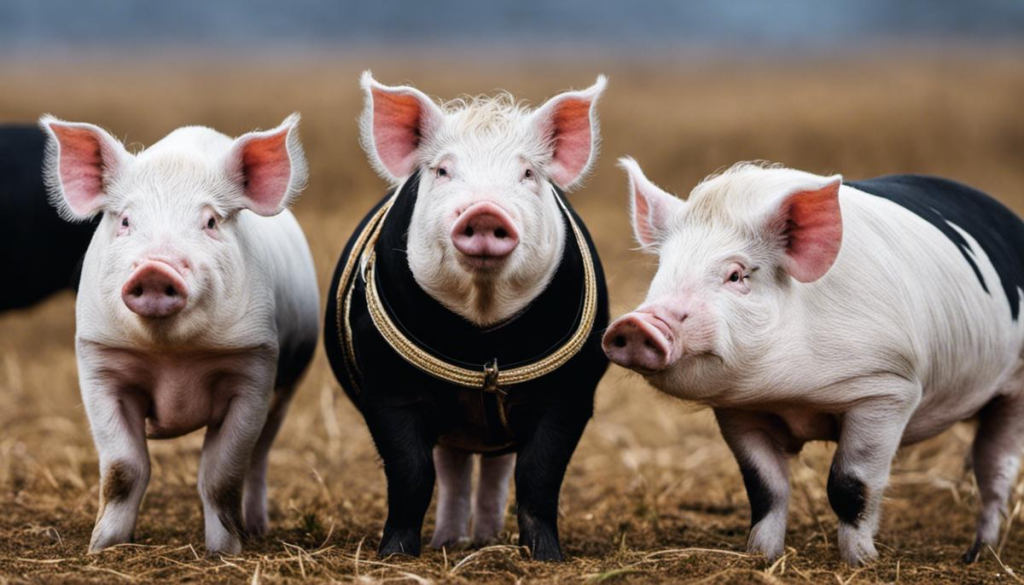The Cinta Senese Pig, an unmistakable beauty hailing from Italy, is cherished as much for its incredible flavour profile in culinary delights as for its rich historical heritage. Boasting distinct characteristics that set this breed apart, the Cinta Senese pig has etched a name for itself in the global swine population. As we delve into valuable insights about this extraordinary animal breed – its unique characteristics, historical background, role in food production, and desperate need for its conservation, we find ourselves on a fascinating journey exploring the multifaceted world the Cinta Senese pigs inhabit.

Understanding the Cinta Senese Pig Breed
Distinctiveness of Cinta Senese Pigs
The Cinta Senese pig breed is a distinctive one with unique physical traits that set it apart from other pig breeds. Originating from the Siena region in Tuscany, Italy, these pigs are one of the few autochthonous swine breeds. They have a characteristic black coat with a white belt, hence the name “Cinta,” which translates to “belt” in Italian.
Genetic Traits
Genetically, Cinta Senese pigs have unique traits that provide them with advantages in specific environments. They are a hardy breed, well-adapted to outdoor rearing and able to resist diseases better than other pig breeds. One of their unique genetic traits is their ability to convert fodder efficiently into lean meat, contributing to the high-quality pork they produce. The meat’s intense flavor and marbling are a result of the breed’s natural propensity for lipid storage.
This breed’s genome also shows signs of having adapted to life in the wild, including developing mechanisms for survival under the challenging conditions of outdoor breeding. These survival traits have contributed to the Cinta Senese pig’s reputation as a breed possessing high rusticity and robustness.
Origins and History
The history of the Cinta Senese breed dates back to the medieval times of Italy, and evidence of the breed can be found in artworks from as early as the 14th century. Historically, these pigs were raised in a semi-wild state, showing a high adaptation to woodland and mountain environments.
Owing to these traits, the Cinta Senese pig became the main breed raised in Tuscany until the 1950s. After this time, however, the breed suffered a drastic decline, pushed to the brink of extinction with only a few hundred purebred individuals left. This decline was due to a shift toward breeds that grew faster and were easier to rear.
Conservation and Recognition
Fortunately, a renewed appreciation for the breed’s distinctive qualities and its cultural significance has led to its recovery. Efforts by dedicated breeders, along with recognition and protection from the European Union and the Italian government, have successfully preserved the Cinta Senese breed. In 2012, the Cinta Senese received Protected Designation of Origin (PDO) status, indicating that the product is produced, processed, and prepared in a specific geographical area and according to distinct traditions.
Behavioral Traits
The Cinta Senese pig breed exhibits distinctive, strong behaviors that reveal their adaptability to outdoor, extensive farming systems. They display a natural tendency to forage and root, utilizing their specialized long snouts, and are able to cover considerable distances in search of food.
Additionally, Cinta Senese pigs are known to be social animals, preferring to live in groups. They are generally calm animals, yet they can be protective and aggressive when threatened.
Appreciating the Cinta Senese pig breed involves understanding its rarity, distinctiveness, and the high-quality of its meat, which altogether makes it remarkable. Tracing this breed’s lineage and looking closely into their unique traits reveals a rich tale of survival, changes, and rejuvenation, deeply embedded in Tuscan culture.

Historical Background of the Cinta Senese Pigs
The Cinta Senese Pigs: A Journey through Time
Deeply intertwined with Tuscan culture and history, the Cinta Senese pigs trace their roots back to the 14th century in Tuscany, Italy. These iconic creatures are featured in the depictions of Siennese School frescoes, highlighting their importance in Tuscany’s way of life.
The late 20th century heralded a revival of sorts for the Cinta Senese breed, following a near extinction during the 1950s and 60s due to shifting agricultural practices and a rising demand for less fatty meats. The necessity to safeguard cultural heritage and biological diversity led to a resurgence in these distinct pigs’ popularity.
The Evolution and Preservation of the Cinta Senese Pigs
Cinta Senese pigs distinguish themselves through their physical attributes and behaviors, evolved over centuries. With their recognizable white “belt” (or ‘Cinta’ in Italian) wrapping around their anterior chest and shoulders against a predominantly black body, Cinta Senese pigs are considered medium to large in size. They are well adapted to Tuscan woodlands, demonstrating impressive foraging skills and favoring acorns.
The resurgence of interest in Cinta Senese pigs led to conservation efforts championed by various local farmers and institutions in the last few decades of the 20th century. It was paramount to prevent the breed from extinction, given its role in the biodiversity of the region.
Their unique genetic traits and ability to adapt to specific environments has inspired scientific research in recent years. These efforts include genetic characterisation studies and observations of their adaptation to different environmental conditions. This research has provided valuable insights regarding breed biodiversity and adaptation – key factors in ensuring the survival and continued growth of the Cinta Senese population.
A Deeper Understanding of Cinta Senese Pigs
Cinta Senese pigs have a significant cultural influence that cannot be overlooked. Historically, these pigs are steeped in folklore and celebrate in local festivals, playing a pivotal role in the culinary customs of the region even today.
These particular pigs are renowned for their superior quality meat. The meat’s rich flavor is highly valued and appreciated in the crafting of premium cured pork products. Coupled with the growing demand for unique gastronomic experiences, the Cinta Senese breed’s popularity has soared, promoting economic benefits for the breed’s preservation.
Its distinct characteristics from historical origins, physical appearance, behavioral flexibility, and cultural significance serve to underline the uniqueness of Cinta Senese pigs. By shedding light on the Cinta Senese, we begin to appreciate the intricate bond between history, culture, and biodiversity that extends far beyond the borders of Tuscany.

Cinta Senese Pigs in Food Production
The Role of Cinta Senese Pigs in Culinary Arts
Cinta Senese pigs, identifiable from their striking black coat and a distinctive muscular band around their midsection, trace their roots back to 14th century Tuscany. A deep-seated appreciation of their uniqueness and origins can pave the path towards understanding their significance in food production.
The breed’s unique flavor profile has made them favorites among chefs around the world. Known for its bold taste, robust texture and well-balanced fat content, Cinta Senese pork is foremost for gourmet cured meats like salami, prosciutto, and pancetta.
Many cherished Italian dishes owe their distinct flavors to the Cinta Senese pig. For instance, the savory yet slightly sweet profile of Prosciutto di Cinta Senese is entirely a result of this breed’s meat. In addition, the lower melting point of this breed’s fat guarantees a swoon-worthy, melt-in-your-mouth feel, much to the delight of seasoned food lovers.
Embracing Sustainable Farming with the Cinta Senese Pig Breed
The Cinta Senese pig breed, known for its unique flavor, contributes significantly to sustainable food production. These pigs thrive on acorns, chestnuts, and other naturally available food sources, reducing the need for synthetic feed. This diverse diet not only influences the distinct flavor of their meat, but also lessens the environmental impact of farming.
This breed’s adaptability further shines in their resilience to disease and unfavourable weather conditions, decreasing the requirement for continuous veterinary care. Cinta Senese pigs are primarily reared in forest habitats where they support the preservation of the ecosystem by decreasing undergrowth and encouraging the growth of fresh grass.
Revitalizing Cinta Senese farming also significantly contributes to the cultural and economic vitality of rural communities. Several farms have achieved organic certification, affirming that the Cinta Senese pigs are raised in humane, eco-friendly conditions.
As a symbol of sustainable and biodiverse farming, the Cinta Senese pig breed exemplifies a successful reincarnation of traditional farming methodologies that equally prioritize superior product quality and environmental concerns. Therefore, appreciating the distinctiveness and origins of Cinta Senese pigs presents a clear understanding of the balance between preserving delectable gastronomic traditions and promoting sustainable food production approaches.

Conservation of Cinta Senese Pigs
Getting to Know Cinta Senese Pigs
Cinta Senese pigs, a celebrated breed hailing from Tuscany, Italy, are renowned for their unique coat coloration and patterns. These pigs often sport white bands–termed as “cinta” in Italian–that encircle their bellies. Their prominent place in the agricultural and culinary history of the region underpins their importance.
Origins of the Cinta Senese Breed
This breed can be traced back to the 1300s. Notably, representations of Cinta Senese pigs have appeared in frescoes and artwork of the period, indicating their significance in societal and cultural contexts. Historically, these animals were raised in semi-wild conditions in the oak and chestnut woods of the region. Key adaptations to these environments, including the pigs’ robustness and their keen rooting and foraging abilities, have contributed to the unique character of the breed.
Conservation of Cinta Senese Pigs
Despite their long history, Cinta Senese pigs faced possible extinction in the 20th century due to the changing agricultural industry. Intensive farming methods and the pursuit of leaner pork led to a sharp decline in the population of Cinta Senese. However, their remarkable resilience coupled with concentrated conservation attempts have ensured their survival.
Conservation strategies
One key conservation strategy for Cinta Senese pigs involves focusing on maintaining its genetic purity. Heritage breeds, including the Cinta Senese, carry unique genes that can help improve disease resistance and adaptability. Furthermore, conservation is being achieved through traditional farming methods. The pigs are allowed to mature naturally in outdoor environments using organic methods, which contributes to the peculiar flavor of their meat.
Role of Conservation Groups and Farmers
Conservation groups, alongside agricultural departments and dedicated farmers, have significantly contributed to the revival of the breed. In 2000, the breed’s designation of origin (PDO) was recognized by the European Union, a significant victory for the breed’s conservation efforts. The PDO recognition not only increases the breed’s commercial value but also supports local traditions and farmers who rear Cinta Senese pigs.
Challenges and Future Prospects
Yet, despite these strides in conservation, Cinta Senese pigs still face threats. They include industrial farming practices, climate change’s impacts on the pigs’ natural habitats and food sources, and a lack of public awareness about the breed’s unique qualities. To help address these challenges, concerted efforts toward public education and promotion of the breed, adoption of sustainable farming practices, and further investment in genetic research are critical. By supporting these efforts, we can contribute towards appreciating and conserving the distinctive heritage of the Cinta Senese pigs.

Photo by joelfilip on Unsplash
From our substantial exploration, it becomes clear that the Cinta Senese pigs are more than just a breed – they symbolize a rich heritage tightly bound to the history of Italy and its culinary culture. Yet, these remarkable pigs face significant challenges, from maintaining their unique traits to their dwindling population. It is heartening to see the collective efforts shared by conservationists, the agriculture community, and farmers alike, accelerating their strides toward securing a safer, brighter future for the Cinta Senese pigs. Their story is a poignant reminder of the ties that bind us to nature, and the shared responsibility we hold in preserving the beautiful diversity it presents to us.